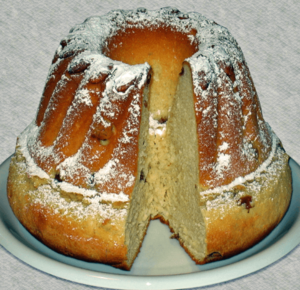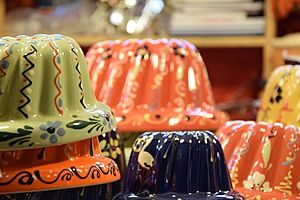Gugelhupf facts for kids
 |
|
| Alternative names | Gugelhopf, Guglhupf, Kugelhopf, bábovka |
|---|---|
| Type | Yeast cake |
| Place of origin | Alsace, Germany, Austria, Switzerland |
| Region or state | Central Europe |
| Main ingredients | flour, baker's yeast with raisins, almonds and rosewater |
A Gugelhupf is a special kind of cake. It's often baked in a unique ring-shaped pan. This gives it a cool, swirly look. Unlike many cakes, Gugelhupf uses baker's yeast to make it rise. This makes it light and fluffy.
You can find Gugelhupf in different flavors. Some are cocoa, others are plain with vanilla and lemon. There are also "marbled" ones that mix both flavors. This cake is very popular in many parts of Central Europe. Countries like Germany, Austria, and Switzerland love it. In the Pennsylvania Dutch area, it's called Deitscher Kuche, which means "German cake."
Long ago, in Austria, Gugelhupf was a big deal. People served it at important events like weddings. They would decorate it with flowers, leaves, and candles. The cake became very popular in the Austro-Hungarian Empire. It was known as a fancy, rich cake. It often had flavors like rosewater and almond. Many different versions of the cake exist today. This shows how much people love Gugelhupf.
Some stories say the cake started in Roman times. Others even link it to the Three Wise Men. Emperor Franz Joseph of Austria helped make it a popular fancy pastry. Marie-Antoinette also helped make it famous in France. In 2006, Gugelhupf was chosen to represent Austria for Europe Day. This was part of the Café Europe project.
Contents
What's in a Name?
The exact origin of the word "Gugelhupf" is a bit of a mystery.
The old name comes from two Middle High German words. Gugel means "hood" or "bonnet." This word is also found in "gugel," which was a type of long-pointed hood. Hupf means "to hop" or "to jump." Some people think "hupf" refers to the dough "jumping" or rising. This happens because of the yeast. But there is no strong proof for this idea.
The first known Gugelhupf recipe was from 1581. It described a "Hat Cake." This cake had a special shape and decorations. This suggests it looked like a medieval hat. This might be why it was called "Gugel," like a hood.
Different Names for Gugelhupf
This cake has many names in different languages:
- In Hungarian, it's called kuglóf.
- In Serbo-Croatian and Macedonian, it's kuglof.
- In Alsatian, it's Kugelhopf.
- In French, it's kouglof.
- In Romanian, it's guguluf.
- In Western Slovenia, it's kuglof.
- In Central and Eastern Slovenia, it's kugluh.
- In Upper Austria, it's called Wacker or Wacka.
- In Czech and Slovak, it's bábovka.
- In Polish, it's babka.
- In Slovenia, the standard word is šarkelj.
What is Gugelhupf Made Of?
Gugelhupf is made with a soft yeast dough. It is baked in a tall, round pan with ridges. This pan also has a hole in the middle. Depending on the region, it might have raisins or almonds. Sometimes, it even has Kirschwasser cherry brandy.
Traditional Gugelhupf always has some dried fruit. Raisins are very common. Other dried fruits, like sour cherries, can be soaked in orange juice or liquor. Some versions from the Czech Republic, Hungary, and Slovakia have a filling. This filling can be sweetened ground poppy seeds or chocolate. It's similar to a Jewish babka cake.
Gugelhupf is not the same as the Italian Christmas cake called pandoro. It's also different from the American Bundt cake. This is because Bundt cakes do not use yeast to rise. Sometimes, a regular pound cake or a marble cake is baked in a Gugelhupf pan. Even without yeast, people might still call it Gugelhupf.
Special Baking Pans
The special circular pan used for Gugelhupf has a tube in the center. These pans were first made from pottery with a shiny coating.
Similar pans are used to make Bundt cakes. The Bundt cake pan shape in the United States actually came from the Gugelhupf pan.
See also
 In Spanish: Gugelhupf para niños
In Spanish: Gugelhupf para niños



